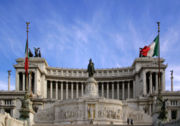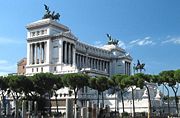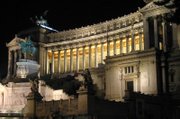- Altare della Patria
-
Das Monumento Nazionale a Vittorio Emanuele II (italienisch; dt.: Nationaldenkmal für Viktor Emanuel II.) ist das nationale Denkmal in Rom, das der italienischen Reichsgründungsbewegung in der ersten Hälfte des 19. Jahrhunderts, dem Risorgimento (Museum im Monument), und dem ersten König des neu gegründeten Italiens, Vittorio Emanuele II., aus dem Haus Savoyen, gewidmet ist. Es liegt am Südende der Via del Corso zwischen der Piazza Venezia und dem Forum Romanum neben dem Trajansforum.
Das Denkmal wurde ab 1885 von Giuseppe Sacconi errichtet, die Einweihung fand 1911 statt. Es wurde aber erst 1927 fertig gestellt. Es ist eine Manifestation der in allen europäischen Ländern vorhandenen nationalistischen Stimmung dieser Zeit, mit wuchtigen Marmortreppen, einer 12 m hohen Bronzeskulptur des reitenden Königs, und einer gewaltigen Säulenreihe am oberen Ende. Diese Portikus wird von einem ornamentalen Temperafries geschmückt (siehe Nachtaufnahme).
Wie bei vielen nationalen Denkmalen üblich, findet man auch hier das Grabmal des unbekannten Soldaten und den Altar des Vaterlandes (ital.: Altare della Patria).
Der Blick von dort auf das Forum Romanum, die Märkte der antiken Kaiser im Südosten, und über die Häuser von Rom nach Norden ist beeindruckend. Angeblich hat man vom Dach des Monumento Vittorio Emanuele aus den besten Blick auf Rom.
Sonstige Bezeichnungen
Das Denkmal wird im Sprachgebrauch kurz nur Il Monumento oder Il Vittoriano genannt. Der Volksmund bezeichnet das oft ungeliebte Monument wegen seiner Form auch als macchina da scrivere (Schreibmaschine) oder auch torta nunziale (Hochzeitstorte), weil der schneeweiße Marmor aus der erdfarbenen Umgebung grell hervorsticht. Auch der Ausdruck Eisberg oder Gebiss ist geläufig.
Weblinks
41.89472222222212.482777777778Koordinaten: 41° 53′ 41″ N, 12° 28′ 58″ O
Wikimedia Foundation.



